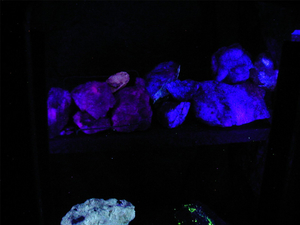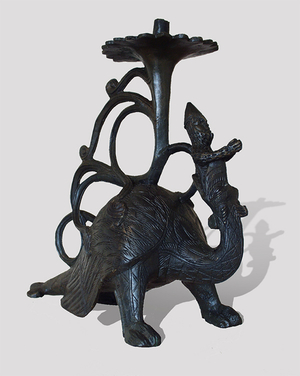Tour
Experience the castle and its features
St. Georgs-Church
In written evidence, a castle chapel is mentioned, which is located halfway between the town of Neuenbürg and the castle. Presumably the church already existed in 1290. After the catastrophic city fire of 1783 it was used as a parish church for a short time. Because of its late medieval wall paintings, the church is one of the most important architectural monuments of the 14th century in Baden-Württemberg. The picturesque half-timbered storey of the tower, on which the medieval construction technology is still recognizable, is characteristic. One of the most beautiful places in the city is the old cemetery in front of the church. From there, especially in the afternoon sun, you can enjoy the view down to the city. In written evidence, a castle chapel is mentioned, which is located halfway between the town of Neuenbürg and the castle.

Presumably the church already existed in 1290. After the catastrophic city fire of 1783 it was used as a parish church for a short time. Because of its late medieval wall paintings, the church is one of the most important architectural monuments of the 14th century in Baden-Württemberg. The picturesque half-timbered storey of the tower, on which the medieval construction technology is still recognizable, is characteristic. One of the most beautiful places in the city is the old cemetery in front of the church. From there, especially in the afternoon sun, you can enjoy the view down to the city.
Mine “Frischglück”
From the castle you walk on the so-called Teichelhangweg (Teichel – wooden water pipe) to the visitor mine “Frischglück” in about 50 minutes. The promising half-height path – the Spectaculum Ferrum path – offers a beautiful view of the city and the surrounding mountains. Iron ore mining around Neuenbürg is around 2500 years old and was a large industrial area with several smelting furnaces as early as Celtic times. At the beginning of the 18th century, Saxon miners began mining the iron ore underground. The ore containing manganese was sold to the hammer forge in Pforzheim and to the scythe forge in Friedrichstal near Freudenstadt.

In 1868, when the tunnel was closed, 20 miners were still employed here. More than 100 years later, citizens voluntarily uncovered the tunnels and made them accessible to visitors. The “Monument to the Old World of Work” is an impressive illustration of how miners from the 18th and 19th centuries dug and worked ore in the Black Forest. The path leads the visitor over several levels with deep insights into the interior of the mountain past “glass heads”, the white shiny barite and black-brown glittering ore. The mine is open from April to the end of October on Saturdays, Sundays and public holidays. From Wednesday to Friday there are additional guided tours by prior arrangement. Information and registration.
Ruin Waldenburg
Opposite the Neuenbürg Castle, on the other side of the Enz, are the remains of the Waldenburg. The history of this castle is largely in the dark as it is not mentioned in written sources. According to the remains of the ruins, the castle consisted of a fortification, a hall, a chapel and several utility rooms. Some pottery finds refer to relationships with the Upper Rhine and the Swabian Alb. During excavations in 1887, a valuable bronze “dragon chandelier” was found, which is now in the Wüttemberg State Museum in Stuttgart. We owe local initiatives to the uncovering of the remains since 1925, the Black Forest Association (local group Neuenbürg) took over the restoration of the ruins from 1993.

Angelstein
The so-called Angelstein can be easily reached after a distance of about one kilometer on a hiking trail that leads from the Waldrennach district north to Neuenbürg. It is located on the eastern slope of the 556 meter high Sägkopf, a wooded knoll between the Enztal in the north and west and the Grösseltal in the east. The conspicuous group of rocks is formed from the rock of the uppermost layer of the middle red sandstone, the upper scree horizon, which was exposed by the eroding effect of the Grösselbach and ice age soil flow. In front of the rock are individual boulders, under whose piled stone slabs there are cave-like rooms, into which the residents of the area are said to have fled in times of war. According to the inscription, a child is said to have been born here in 1796 during a French invasion.
Former castle of Straubenhardt and the Schwabentor
Only a few loose stone remains and earth walls indicate the former site of Straubenhardt Castle. The ruin lies on a mountain spur high above the Enz and was originally the seat of the Lords of Straubenhardt. In the Middle Ages, the demarcation line between Baden and Württemberg ran not far from the castle. The Schwabentor near the castle is a remnant of a presumably medieval customs post. With the help of a toll tower, the customs post could even control raftsmen and charge them with customs duties. In 1930 the stone pillars, on which the devices for the barrier can still be clearly seen, were restored. Straubenhardt Castle also came between the two domains, because in 1381 a treaty between Baden and Württemberg stipulated that the castle, which had already been destroyed now, could no longer be rebuilt.
Schwedenschanze
On the Wilhelmshöhe Neuenbürg between the road to Arnbach and the forest path to Gräfenhausen, the earth walls and the surrounding moat of an old ski jump can be seen in good condition. The name “Schwedenschanze” is based on the legend that in the Thirty Years’ War the Swedes also appeared as enemies in front of Neuenbürg; they had shot at the castle with cannons from a square hill on Wilhelmshöhe. There is no reliable information about this, and it is also unlikely that the Protestant Swedes would have shot at a castle belonging to the Protestant Duke of Württemberg, who was not at war with them, apart from the question of whether the cannons already reached that far at that time. But since there is no report about the real builder of the hill, it may keep its popular name.
